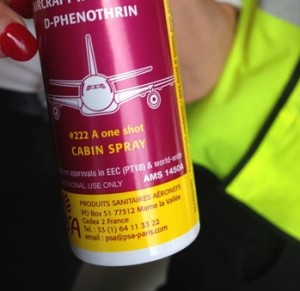
More evidence that low-calorie sweeteners are bad for your health
Studies show that artificial sweeteners can raise the risk of hypertension, metabolic syndrome, type 2 diabetes and heart disease, including stroke.

An American woman flying to Perth, Australia was recently escorted off the plane by six police officers because she questioned the practice of spraying of insecticides in a plane full of people.
Petra Haluska posted an emotional video on facebook immediately after the immigration officials released her – and perhaps not surprisingly the story has been making the rounds of the natural health news sites.
It’s hard to know where to begin the discussion about this issue – but discuss it we should.
For many people this may be the first time that they have heard of this practice – known as ‘disinsection’, and yet, spraying passengers with insecticides is a long established routine which airlines employ to ensure that people don’t bring ‘bugs’ into another country.
Though most of us never see it, planes are a fumigated regularly between flights (known as residual disinsection). But many countries also carry out disinsection in-flight too.
This involves the flight crew walking up and down the aisles spraying quick-acting insecticides directly onto passengers. It’s a practice that has become more visible with the spread of the zika virus.
Coffee, tea or DDT?
From the 1940s to the 1970s airlines regularly sprayed planes, and sometimes passengers, with DDT. In the 80s and 90s some US airlines reported spraying passengers with chlorpyrifos. Both are potent nerve and reproductive toxins.
DDT has since been banned, but the WHO still uses it as a reference standard for the toxicity of in-flight sprays. Since1985 it has required that in flight disinsectants be “not inferior to [a] standard reference aerosol” containing 3% DDT, 1.6% pyrethrum, 7.5% xylene, 2.9% petroleum distillate, and 85% CFCs.”
The most common active ingredients of today’s in-flight disinsectants are synthetic pyrethroids such as d-phenothrin, permethrin, and resmethrin. The active ingredient, as well as the so-called inactive ingredients, can all be irritating to skin and mucous membranes. But pyrethroids are also hormone disrupting, neurotoxic and carcinogenic.
No monitoring of health effects
Airplane cabin air is already worryingly toxic and disinsection just adds to the soup.
The WHO says that there is never been a reported case of a passenger becoming ill from disinsection. But how would they know? Who exactly is monitoring passenger health? And how?
In addition, who is monitoring the health of flight crews who, through residual and in-flight spraying, probably receive the largest overall dose of these chemicals?
Independent studies of flight crews in Australia report symptoms such as sinus problems, swollen and itchy eyes, cough, difficulty breathing, loss of voice, skin rashes/hives, severe headaches and fatigue. In more serious cases, chronic damage to both the nervous system (e.g., memory loss, peripheral neuropathy) and the immune system (e.g., severe fatigue, heightened sensitivity to chemical exposures) have been reported.
As far back as 1979 the US CDC noted that in-flight sprays caused “undue discomfort to many passengers, and, in some cases, place those exposed at risk of developing acute allergic (anaphylactic) reaction…” But if you are a passenger who experiences what you believe to be an adverse reaction to an insecticide spray, who would you tell? How could you prove it?
A false solution
In 1996, an Australian review called for the disinsection to be discontinued, stating that the risk of disease spread by “infected travellers arriving by air is likely to be far higher than any risk of arrival of infected insect vectors on aircraft…”
This is a key point since the mosquitoes that carry diseases like zika are not likely to be sitting on the shoulders of aircraft passengers. The more pressing issue – as with influenza and SARS – is passengers infected with viruses that can be spread through human contact.
In addition, the spread of mosquitoes is down to a combination land use changes and climate change. Dousing passengers with insecticides does nothing to address these and even risks encouraging insecticide resistance (already well documented).
New rules to protect passengers
Pesticides on planes are a fake solution to a real problem. Yet, as a passenger you sign away your rights to complaint or redress when you purchase your ticket.
If airlines are going to continue the practice of spraying insecticides on planes and people, then the following needs to happen:
As each passenger boards the plane, they should be given an information card telling them that they will be sprayed. It should include the brand name and full formulation of the insecticide being used, its purpose and mode of action as well as potential adverse effects. It should also include the contact details of the manufacturer.
There should be contact information for a relevant national/international health authority where people can report adverse reactions and contact information for the airline so that people can register their comments and concerns on being sprayed with insecticides.
In addition, if airlines and health authorities are not willing to properly monitor insecticide exposure on aircraft, then it should be made absolutely clear, at the time of booking, that you will be flying on a plane where you will be sprayed. That way passengers can make an informed choice whether or not to purchase that ticket.
It may interest you to know that in 1995 when US authorities proposed a rule that passengers should receive notice of disinsection prior to booking, many countries dropped their requirement for in-flight spraying on flights from the US. Something that can be dropped so easily – likely for fear of reduced passenger traffic – is probably not all that important and is long overdue to be scrapped.
Pat Thomas, Editor

Please subscribe me to your newsletter mailing list. I have read the
privacy statement